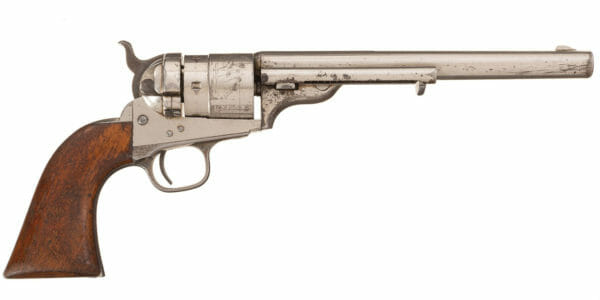
New York – -(AmmoLand.com)- On December 23, 1833, Charles Richards was born in Brooklyn, New York. He would eventually go on to spend 34 years teaching mechanical engineering at Yale, but he is more widely known in the arms industry as one of the men behind revolver cartridge conversions and the Single Action Army.
Well educated in New York and New Jersey, Richards did not initially set out on a path that would lead him to firearms development. Instead, he apprenticed at a manufacturing plant. From there, he spent three years (1855-58) working for Colt’s, but left to take a job as a foreman in another manufacturing plant. Engineering was his bailiwick, not guns.
He spent a couple years as a design engineer and helped other inventors secure patents, all while he worked to secure his own patent for an improvement on the steam engine. With the outbreak of the Civil War in April 1861, he went back to Colt’s, where the arms industry was in full swing providing for the war effort. It proved to be the perfect place for Charles’ fondness for engineering and development.
The Civil War era – and the handful of years immediately following it – were an incredible time for arms development and invention. Most of this was due to the patent held by Rollin White and Smith & Wesson regarding the bored through cylinder. This meant that gun companies had to get creative with ways to fire and extract self-contained metallic cartridges, lest they find themselves bogged down in myriad court cases with White.
Richards’ first attempt at legally circumventing White’s patent was a design known simply as the “Richards Conversion.” Utilizing the .44 caliber Colt Model 1860 Army revolver, the rear portion of the cylinder with the percussion cones was machined off and replaced with a breech plate that contained the rear sight and firing pin. The loading lever required on the percussion version was removed and replaced by an ejector rod.

Similar conversions were performed in short order for the Colt Model 1851 and Model 1861 Navy revolvers. These .36 caliber percussion guns were converted to fire .38 rimfire cartridges.
What soon followed was the “Richards-Mason Conversion,” so named for Charles and another Colt’s employee, William Mason. This design moved the rear sight back to the hammer, which also contained the firing pin. The method for attaching the ejector rod was also simplified.
Like Mason, Richards’ main claim to fame was not with cartridge conversions of percussion pistols. Instead, the two men were the brains behind the most well-known revolver of the Old West – the Colt Single Action Army, affectionately known by many as the “Peacemaker.”

Richards and Mason collaborated on one final pistol, the Colt M1878 Frontier double-action revolver, before Charles Richards retired in 1880.
He did not, however, sit still in retirement. That same year, he helped found the American Society of Mechanical Engineers (ASME). Today, the organization boasts more than 110,000 members in more than 150 countries worldwide. Charles spent nine years filling the roles of manager and vice president with the society before moving on once again.
After spending four years as both the Vice President of the American Society of Mechanical Engineers and a professor at Yale, he left ASME to teach full-time. He spent 34 years at Yale, 25 of which he spent as the Chair of their mechanical engineering department.
Charles Richards died on April 20, 1919, at the age of 85. He had spent 22 years – fully one-quarter of his life – working for Colt’s. I don’t think it’s an overstatement to say that his contributions to the world of firearms were vital to helping put the industry on the path to where it is today.
About Logan Metesh
Logan Metesh is a historian with a focus on firearms history and development. He runs High Caliber History LLC and has more than a decade of experience working for the Smithsonian Institution, the National Park Service, and the NRA Museums. His ability to present history and research in an engaging manner has made him a sought after consultant, writer, and museum professional. The ease with which he can recall obscure historical facts and figures makes him very good at Jeopardy!, but exceptionally bad at geometry.

